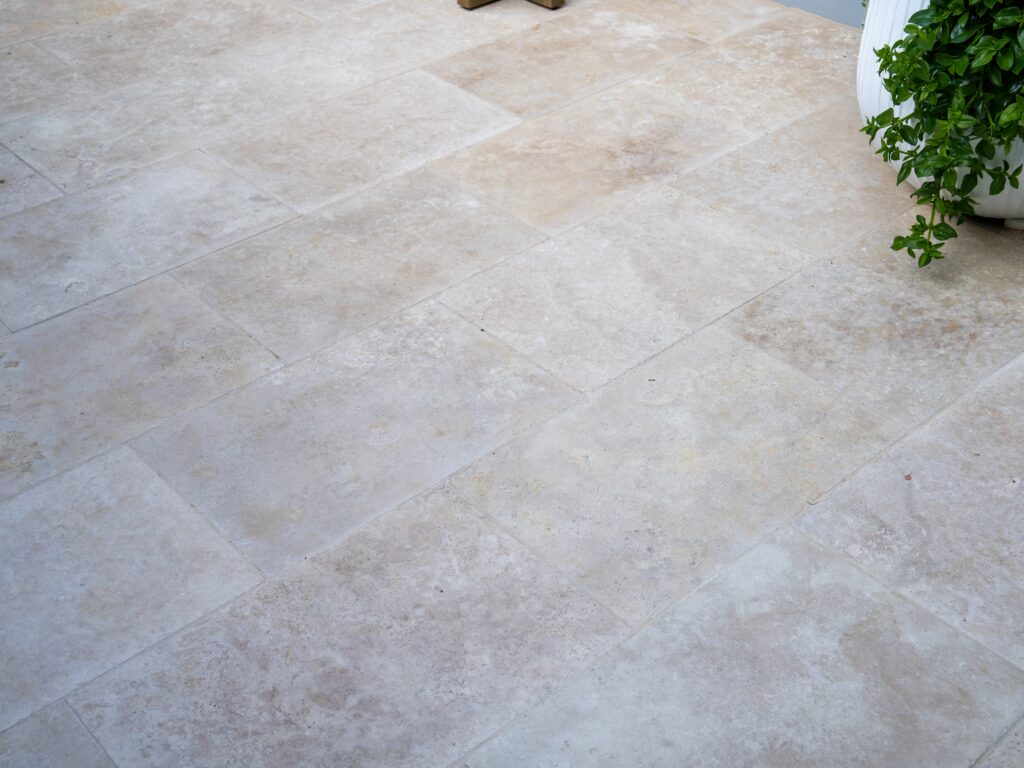Travertine tiles and pavers are a popular choice for both indoor and outdoor areas due to their natural beauty, timeless appeal, and durability. However, like any natural stone, they require regular maintenance to preserve their appearance and longevity. Proper cleaning and sealing are key to ensuring that your Travertine tiles and pavers maintain their elegance for years to come. In this guide, we’ll walk you through the steps to clean and seal Travertine effectively, so you can enjoy its beauty without worry.
Why Travertine Needs Maintenance
Travertine is a natural limestone formed in hot springs and caves. Its porous nature gives it a distinct, earthy appeal, but also makes it more susceptible to staining and damage if not properly cared for. Everyday use, exposure to the elements (for outdoor pavers), and accidental spills can cause Travertine to lose its sheen or develop unsightly marks. Regular cleaning and sealing help protect the stone from these issues while keeping it looking pristine.
How to Clean Travertine Tiles and Pavers
Cleaning Travertine requires a gentle approach to avoid damaging the stone’s surface. Here’s how you can keep your Travertine clean:
1. Regular Cleaning
- Dust and Sweep Frequently: For indoor Travertine tiles, regular dusting or sweeping is important to prevent dirt and grit from scratching the surface. Use a soft broom or dust mop to avoid abrasive contact.
- Outdoor Pavers: For outdoor Travertine pavers, sweep the surface with a soft broom to remove leaves, dirt, and debris. You can also use a blower to clear larger areas quickly.
2. Mopping and Washing
- Use a pH-Neutral Cleaner: It’s important to use a pH-neutral cleaner specifically designed for natural stone. Harsh chemicals or acidic cleaners, like vinegar or bleach, can damage Travertine and dull its surface. Mix the cleaner with warm water according to the manufacturer’s instructions.
- Damp Mop for Indoors: For indoor Travertine tiles, use a damp mop to clean the surface. Make sure the mop is not too wet as excessive moisture can seep into the pores of the stone.
- Pressure Washing for Outdoors: For outdoor Travertine pavers, you can use a pressure washer set to a low to medium setting. This will help remove dirt and grime without damaging the stone. Be careful not to hold the washer nozzle too close to the surface, as high-pressure water can erode the Travertine.
3. Spot Cleaning Stains
- Act Quickly: If something spills on your Travertine tiles or pavers, clean it up as soon as possible. The longer a substance sits on the stone, the more likely it will leave a stain.
- Use a Stone-Safe Cleaner: For tougher stains, use a stone-safe cleaner. Avoid abrasive scrubbers or pads, as they can scratch the surface. For oil-based stains, you might need to use a poultice (a mixture of cleaning powder and water) to draw out the stain.
How to Seal Travertine Tiles and Pavers
Sealing Travertine is essential to protect the stone from stains and weathering, especially in outdoor areas where exposure to water, sun, and temperature changes can take a toll. Here’s a step-by-step guide to sealing your Travertine tiles and pavers:
1. Choose the Right Sealer
There are two main types of sealers for Travertine:
- Penetrating Sealers: These sealers absorb into the stone, providing protection from within. They are ideal for areas where you want to maintain the natural look of Travertine.
- Topical Sealers: These sealers sit on top of the stone and create a barrier. They can enhance the stone’s appearance by adding a glossy or matte finish. Topical sealers are more common for outdoor pavers, as they offer better protection from the elements.
2. Clean the Surface
Before sealing, make sure your Travertine is thoroughly cleaned and completely dry. Any dust, dirt, or moisture left on the surface can interfere with the sealer’s effectiveness. For outdoor pavers, allow at least 24-48 hours of dry weather before sealing.
3. Apply the Sealer
Follow the instructions on your chosen sealer. Use a paintbrush or roller to apply the sealer evenly across the surface. For indoor Travertine tiles, you can use a sponge or cloth for more precision.
- Multiple Coats: Depending on the type of sealer, you may need to apply multiple coats. Allow each coat to dry completely before applying the next one.
- Wipe Off Excess: After applying the final coat, wipe off any excess sealer with a clean, dry cloth to prevent streaking or residue build-up.
4. Allow the Sealer to Cure
After sealing, give the Travertine enough time to cure before walking on it or placing any furniture on it. This typically takes 24-48 hours, but it’s best to follow the manufacturer’s recommendations.
5. Re-Seal Periodically
Travertine sealers don’t last forever. Indoor tiles typically need resealing every 1-2 years, while outdoor pavers exposed to the elements may require sealing every 6-12 months. To check if your Travertine needs resealing, sprinkle a few drops of water on the surface. If the water absorbs quickly, it’s time to re-seal.
Final Tips for Long-Lasting Travertine
- Use Rugs and Mats: For indoor areas, place rugs or mats in high-traffic zones to protect your Travertine from scratches.
- Furniture Pads: Use felt pads under furniture legs to prevent scratching.
- Avoid Harsh Chemicals: Always use stone-safe products for cleaning Travertine.
Conclusion
Travertine tiles and pavers are a beautiful, durable option for both indoor and outdoor spaces, but they do require regular cleaning and sealing to maintain their longevity and beauty. By following the steps outlined above, you can ensure your Travertine remains a stunning feature in your home for many years to come. Regular maintenance will not only enhance the natural elegance of the stone but also protect your investment over time.

